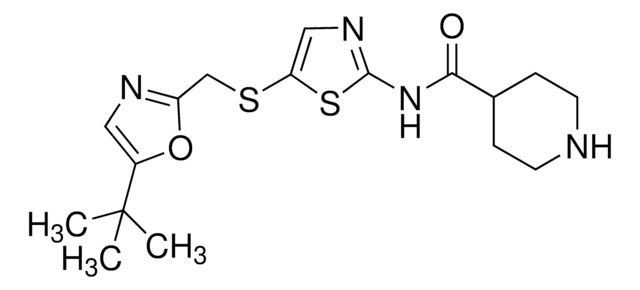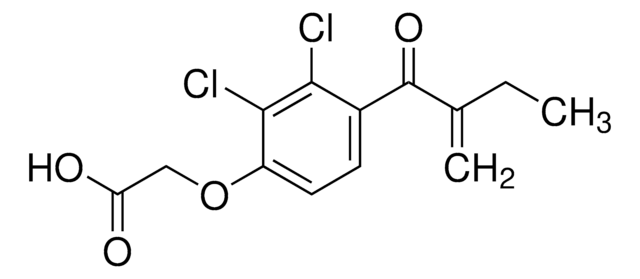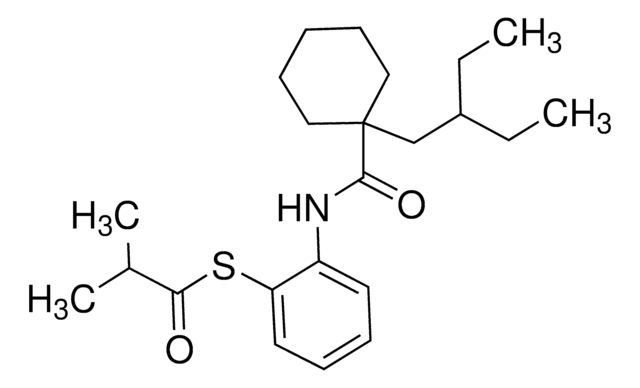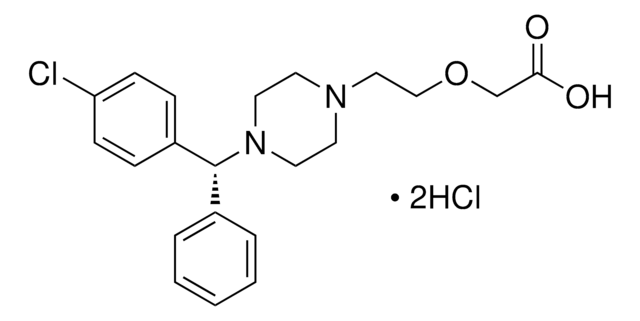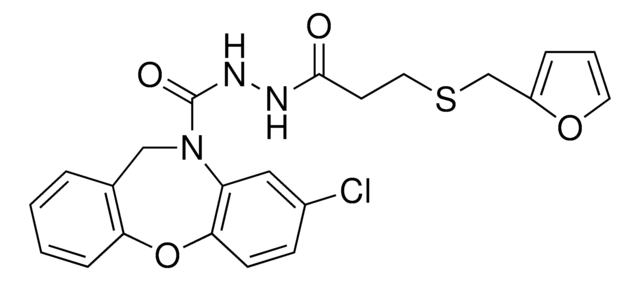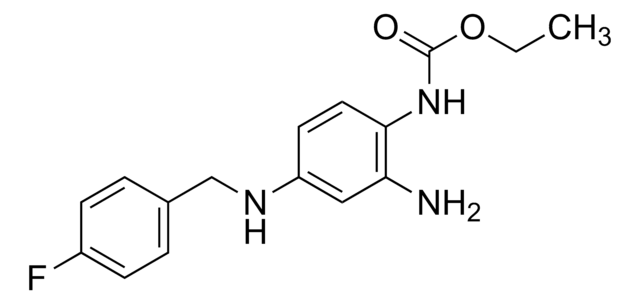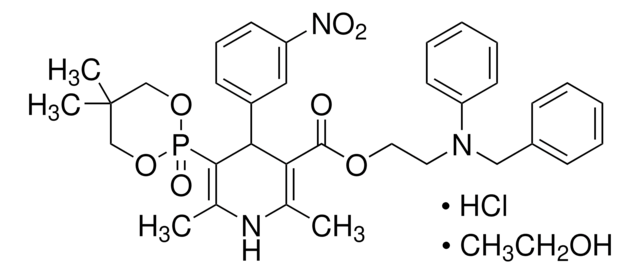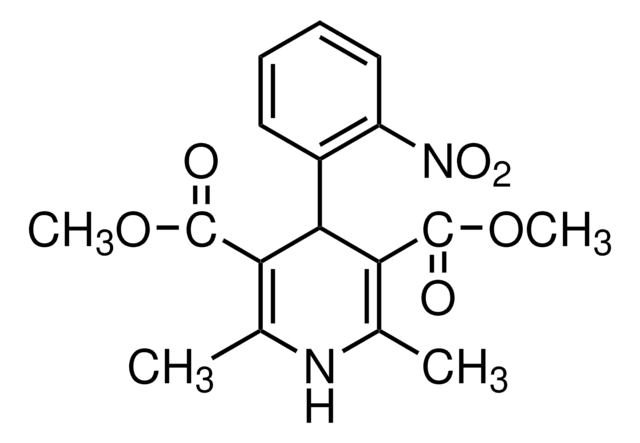All Photos(1)
Synonym(s):
1,4-Dihydro-2,6-dimethyl-4-(3-nitrophenyl)-3,5-pyridinedicarboxylic acid hydrchloride, 2-[4-(diphenylmethyl)-1-piperazinyl]ethyl methyl ester, 3-(2-(4-Benzhydrylpiperazin-1-yl)ethyl) 5-methyl 2,6-dimethyl-4-(3-nitrophenyl)-1,4-dihydropyridine-3,5-dicarboxylate hydrchloride, CV 4093 hydrchloride, CV-4093 hydrchloride, CV4093 hydrchloride, Franidipine hydrchloride, Manidipine 6300 hydrchloride
Empirical Formula (Hill Notation):
C35H38N4O6 · xHCl
CAS Number:
Molecular Weight:
610.70 (free base basis)
MDL number:
UNSPSC Code:
12352200
NACRES:
NA.77
Recommended Products
Assay
≥98% (HPLC)
form
powder
storage condition
desiccated
color
white to beige
solubility
DMSO: 2 mg/mL, clear (warmed)
storage temp.
2-8°C
Related Categories
Biochem/physiol Actions
Manidipine is a dihydropyridine class calcium channel blocker (CCB) that exerits its antihypertensive activity via targeting both L-type and T-type calcium channels. In contrary to other dihydropyridines and non-dihydropyridines that mainly act as L-type CCBs, Manidipine diminishes glomerular pressure and, consequently, albumin excretion via its action against T-type channels of efferent arterioles in addition to promoting afferent arteriole dilation by blocking L-type channels. Clinically, Manidipine is as effective in lowering blood pressure as other dihydropyridines, while only Manidipine significantly reduces albuminuria and insulin resistance with less adverse effects. In obese and hypertensive individuals, Manidipine is more effective than Lercanidipine in reducing insulin resistance, while Nifedipine treatment is reported to increase insulin desensitisation.
Signal Word
Danger
Hazard Statements
Precautionary Statements
Hazard Classifications
Acute Tox. 3 Oral - STOT SE 3
Target Organs
Central nervous system
WGK
WGK 3
Flash Point(F)
Not applicable
Flash Point(C)
Not applicable
Certificates of Analysis (COA)
Search for Certificates of Analysis (COA) by entering the products Lot/Batch Number. Lot and Batch Numbers can be found on a product’s label following the words ‘Lot’ or ‘Batch’.
Already Own This Product?
Find documentation for the products that you have recently purchased in the Document Library.
K Okabe et al.
The Journal of pharmacology and experimental therapeutics, 243(2), 703-710 (1987-11-01)
Effects of CV-4093, a newly synthesized dihydropiridine type of Ca antagonist, on membrane currents in enzymatically dispersed single smooth muscle cells of the rabbit main pulmonary artery were investigated using the single electrode voltage clamp method. Three types of membrane
Margarita Saiz-Satjes et al.
Future cardiology, 13(2), 143-151 (2016-11-26)
In AMANDHA trial, the addition of manidipine, but not amlodipine, in diabetic patients with uncontrolled hypertension, microalbuminuria and preserved renal function resulted in a large decrease of urinary albumin excretion (UAE) despite similar blood pressure (BP) reductions. Factors associated with
H Nakaya et al.
European journal of pharmacology, 146(1), 35-43 (1988-01-27)
The effects of CV-4093, a new dihydropyridine derivative, on isolated cardiovascular tissues were compared with those of several dihydropyridine and non-dihydropyridine calcium antagonists. CV-4093 effectively inhibited the contractions induced in canine femoral arteries by high [K+]0 and Bay K 8644
N Buset Ríos et al.
Nefrologia : publicacion oficial de la Sociedad Espanola Nefrologia, 31(3), 268-274 (2011-03-17)
The combination of renin-angiotensin system blockers with calcium channel blockers appears to be one of the most effective options for treating hypertension and diabetes.Nevertheless, not all calcium blockers behave in the same manner. Manidipine, unlike other third-generation dihydropyridine derived drugs
Christian Ott et al.
British journal of clinical pharmacology, 75(1), 129-135 (2012-12-18)
Intraglomerular pressure is one of the main drivers of progression of renal failure. Experimental data suggest that there are important differences between calcium channel blockers (CCBs) in their renal haemodynamic effects: manidipine reduces, whereas amlodipine increases intraglomerular pressure. The aim
Our team of scientists has experience in all areas of research including Life Science, Material Science, Chemical Synthesis, Chromatography, Analytical and many others.
Contact Technical Service